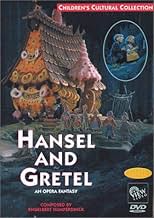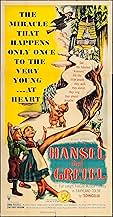CALIFICACIÓN DE IMDb
6.4/10
298
TU CALIFICACIÓN
Agrega una trama en tu idiomaAn "electronic puppet" version of the Humperdinck opera, adapted for children and using spoken dialogue as well as Humperdinck's music.An "electronic puppet" version of the Humperdinck opera, adapted for children and using spoken dialogue as well as Humperdinck's music.An "electronic puppet" version of the Humperdinck opera, adapted for children and using spoken dialogue as well as Humperdinck's music.
- Dirección
- Guionistas
- Elenco
- Premios
- 1 premio ganado y 1 nominación en total
Frank Rogier
- Father
- (voz)
Helen Boatwright
- Dew Fairy
- (voz)
- (as Helen Boatright)
Constance Brigham
- Hansel
- (voz)
- …
- Dirección
- Guionistas
- Todo el elenco y el equipo
- Producción, taquilla y más en IMDbPro
Opiniones destacadas
Despite its European, "old world" look, Hansel and Gretel was made in New York City. Indeed the comments to the contrary are a tribute to the filmmakers' success in evoking a genuine fairy tale style. Nonetheless, the film was shot using conventional stop-motion puppets (notwithstanding the producer's claims to using some sort of mysterious "electronic" method) in the main room of an abandoned courthouse which is still standing at the corner of Second Avenue and Second Street in New York City. The large set was built in the main chamber on the second floor (now the largest of several theaters in what is currently (2005) the Anthology Film Archives).
Apparently electromagnets were used to hold the stop-motion puppets in place during some sequences, but normal procedures were used for the rest. This and some hype that lured in backers may account for the mistaken report that they are electronic puppets. They were solid, armature puppets and not clay (or "claymation") dolls.
The set survived the production and actually toured county fairs as a fairy tale exhibit for many years after the completion of the film.
Apparently electromagnets were used to hold the stop-motion puppets in place during some sequences, but normal procedures were used for the rest. This and some hype that lured in backers may account for the mistaken report that they are electronic puppets. They were solid, armature puppets and not clay (or "claymation") dolls.
The set survived the production and actually toured county fairs as a fairy tale exhibit for many years after the completion of the film.
This is a stop-motion animation film of the Hansel and Gretel fairy tale, done, apparently, somewhere in Europe--the Austrian Apollo Boys Choir does the background vocals, so the film could have been made there or in nearby Hungary or Czechoslovakia, both of which were producing well-done animation films--but passed off as an American film, which it is not. Considering the time it was made and the conditions existing in Europe during that period, it is an admirable attempt indeed. The stop-motion, while not up to the standards of Ray Harryhausen, who was doing similar work at the time, is still well-done, and great care was obviously taken in the dubbing and scoring of the film. The background music is at times a bit overpowering, and there are spots where the dialogue is drowned out by it, but there are some imaginative touches throughout and and some visually beautiful moments. Children who are used to today's high-tech computer animation may not be impressed technically, but the film overall should appeal to them. Recommended.
I found the other comments to be enlightening, especially with regard to the hurry-up conclusion.
However, I know for a fact that the boys' choir used in this movie was no a European choir, but the Apollo Boys Choir, originally of Palm Beach, Florida, that moved to Dallas, Texas until its director, Coleman Cooper, retired. It is unfortunately no longer in operation. During the Depression, the choir toured the United States in limousines, not buses, and sang for President Roosevelt at the Hot Springs resort where he escaped the pressures of Washington DC. The choir accompanist, Mr. Bert Hallack, is a resident of Palm Beach.
One famous former chorister of this choir is George Bragg, who founded the Texas Boys Boys (of Fort Worth).
However, I know for a fact that the boys' choir used in this movie was no a European choir, but the Apollo Boys Choir, originally of Palm Beach, Florida, that moved to Dallas, Texas until its director, Coleman Cooper, retired. It is unfortunately no longer in operation. During the Depression, the choir toured the United States in limousines, not buses, and sang for President Roosevelt at the Hot Springs resort where he escaped the pressures of Washington DC. The choir accompanist, Mr. Bert Hallack, is a resident of Palm Beach.
One famous former chorister of this choir is George Bragg, who founded the Texas Boys Boys (of Fort Worth).
The story/fairy-tale is one of the best-known and is a timeless one, while Humperdinck's opera still enchants me after being first acquainted with it 11 or so years ago. It is also one of the most accessible operas(with the music not too heavy and it's a story almost everybody knows) and one of the few to translate well into English.
This 1954 film does get a little hurried visually and narratively at the end, but is overall one of the best versions of both the fairy-tale and the opera(I personally saw it for the first time recently so don't have nostalgic bias for it). The visuals are beautiful and clever, charming in the lighter parts and atmospheric in the darker parts. The amount of effort put into making the film is more than evident throughout. Humperdinck's music is enchanting and is not trivialised whatsoever here, it's played with energy and depth by the orchestra and beautifully paced. The choral singing is well-balanced and committed, if recording the music was indeed punishing it doesn't show at all in the singing.
Hansel and Gretel(1954) works well also in the writing and story departments. The script is whimsical and witty, enough to make one laugh, bite the nails and occasionally cry(not exactly emotionally but because there are scenes done so beautifully that it does evoke some emotion, notably the dream pantomime). The storytelling is close in detail and spirit to both the fairy-tale's story and the opera and captures the essence of both. Filled with cute animals, charmingly lovely moments like the dream pantomime(figuratively and literally heavenly here), funny moments- both light hearted and dark- like with the chemistry between Hansel and Gretel and especially the witch, whimsy and darkly scary moments like with again the witch, there is enough to captivate children and adults alike, not making the mistake of making it too scary for children or too juvenile for adults.
All the characters engage in personality and there is a real attempt to make them individual, the most memorable and most colourful character being quite easily the witch. All the acting and singing is top-notch, several have picked out Anna Russell as the standout and I am going to whole-heartedly agree, Russell is hilarious and genuinely creepy as the witch and was clearly having a whale of a time. That does not mean though that the likes of Mildred Dunnock, Frank Rogier and Christine Brigham didn't excel, they certainly did in fact with Dunnock an authoritative and no-nonsense mother-figure, Rogier is a Father that is easy to feel sorry for and Brigham's Hansel and Gretel are both spirited and appealing. Just that Russell made the biggest impression. Overall, fantastical in every sense, for lovers of the story, the opera or both this is a version that is not to be missed. 10/10 Bethany Cox
This 1954 film does get a little hurried visually and narratively at the end, but is overall one of the best versions of both the fairy-tale and the opera(I personally saw it for the first time recently so don't have nostalgic bias for it). The visuals are beautiful and clever, charming in the lighter parts and atmospheric in the darker parts. The amount of effort put into making the film is more than evident throughout. Humperdinck's music is enchanting and is not trivialised whatsoever here, it's played with energy and depth by the orchestra and beautifully paced. The choral singing is well-balanced and committed, if recording the music was indeed punishing it doesn't show at all in the singing.
Hansel and Gretel(1954) works well also in the writing and story departments. The script is whimsical and witty, enough to make one laugh, bite the nails and occasionally cry(not exactly emotionally but because there are scenes done so beautifully that it does evoke some emotion, notably the dream pantomime). The storytelling is close in detail and spirit to both the fairy-tale's story and the opera and captures the essence of both. Filled with cute animals, charmingly lovely moments like the dream pantomime(figuratively and literally heavenly here), funny moments- both light hearted and dark- like with the chemistry between Hansel and Gretel and especially the witch, whimsy and darkly scary moments like with again the witch, there is enough to captivate children and adults alike, not making the mistake of making it too scary for children or too juvenile for adults.
All the characters engage in personality and there is a real attempt to make them individual, the most memorable and most colourful character being quite easily the witch. All the acting and singing is top-notch, several have picked out Anna Russell as the standout and I am going to whole-heartedly agree, Russell is hilarious and genuinely creepy as the witch and was clearly having a whale of a time. That does not mean though that the likes of Mildred Dunnock, Frank Rogier and Christine Brigham didn't excel, they certainly did in fact with Dunnock an authoritative and no-nonsense mother-figure, Rogier is a Father that is easy to feel sorry for and Brigham's Hansel and Gretel are both spirited and appealing. Just that Russell made the biggest impression. Overall, fantastical in every sense, for lovers of the story, the opera or both this is a version that is not to be missed. 10/10 Bethany Cox
Although this film may look like it was from Eastern Europe, it was definitely made in New York City. I was a member of the Apollo Boys Choir in 1953(we were from Palm Beach, Florida), and I remember visiting the studio in New York while the film was being shot. We came up from Palm Beach in the fall to record our part of the sound track. The choir director, Coleman Cooper, was a perfectionist, and we worked harder on this music than any other set of pieces I can remember. Unfortunately, by the time we got to New York we were pretty sung out. The recording session was long, and during it the producer decided that our sound needed some bolstering, so he brought in several female members of the Metropolitan Opera Chorus to help out. Mr. Cooper must have been very disappointed. This was an important project for him. We boys were a little disappointed too. I, at least, quickly got over it. The women, of course, were excellent singers, several were quite attractive, and they thought we were cute.
¿Sabías que…?
- TriviaRe-released in 1972 as part of MGM's Children's Matinees package.
- ConexionesFeatured in Animation Lookback: The Best of Stop Motion - The First Features (2014)
Selecciones populares
Inicia sesión para calificar y agrega a la lista de videos para obtener recomendaciones personalizadas
Detalles
- Tiempo de ejecución1 hora 12 minutos
- Mezcla de sonido
Contribuir a esta página
Sugiere una edición o agrega el contenido que falta

Principales brechas de datos
By what name was Hansel y Gretel (1954) officially released in Canada in English?
Responda



















